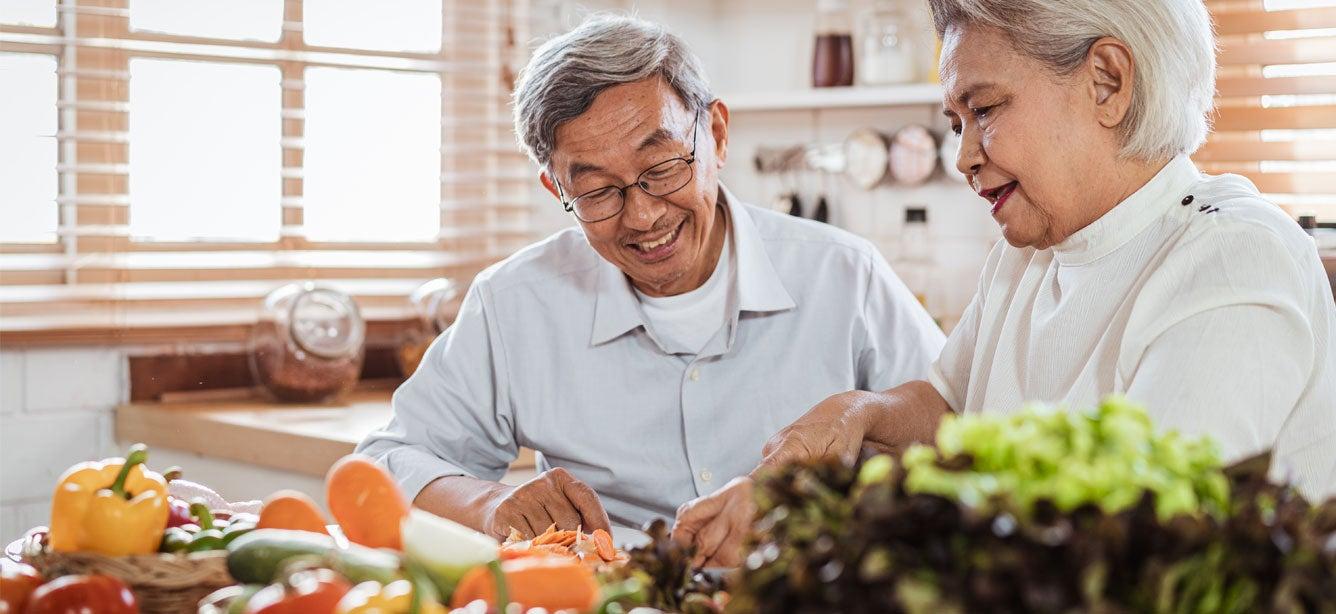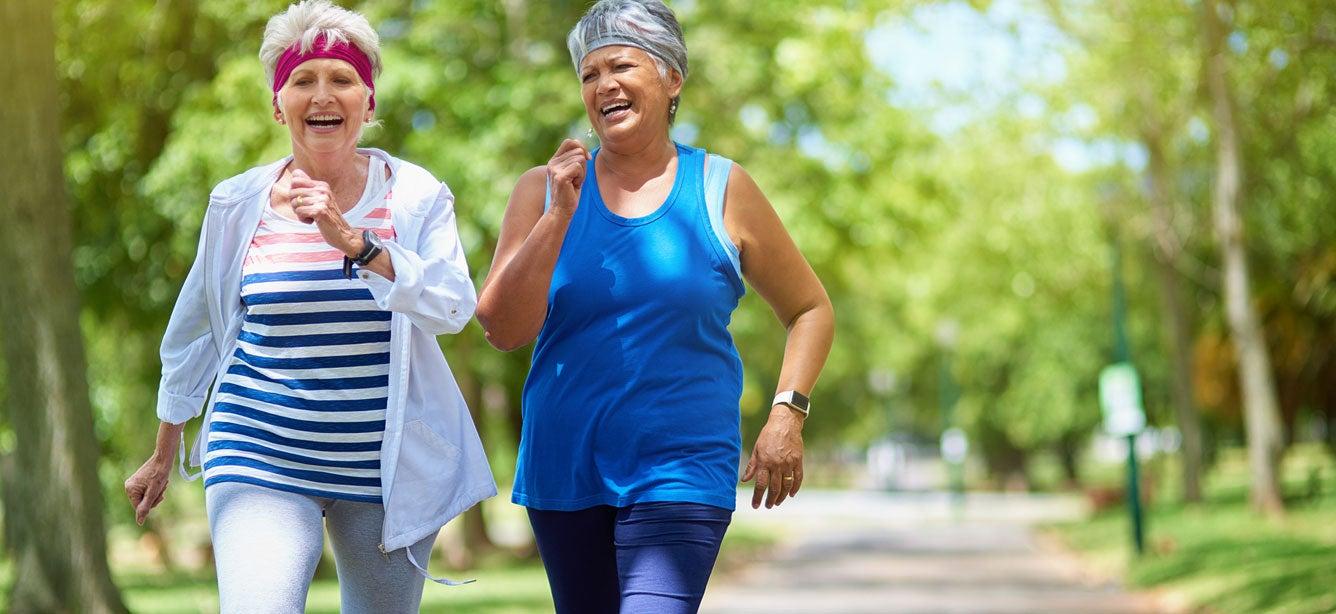Get Cooking! Top Tips for Older Adults Managing Arthritis Hand Pain
6 min read

Related Topics
Arthritis is a reality for almost half (47.3%) of U.S. adults who are 65 and older. According to the 2019-2021 National Health Interview Survey, 53.2 million U.S adults were diagnosed in that timeframe with some form of arthritis—rheumatoid arthritis, gout, lupus, or fibromyalgia—17.9% of men and 24.2% of women.1
Arthritis pain can have a significant impact on many areas of your health and well-being, especially when it affects your hands. The loss of control in your hands can lead to less participation in activities that are important to you. That's why managing your arthritis pain is important in helping you to continue performing those activities.
Below are some tips you can use to help manage pain from arthritis and improve your ability to continue cooking your favorite dishes!
How to protect your joints
Sometimes our “normal” way of doing things can increase stress on our joints, which in turn increases pain, stiffness, and could even worsen your condition. Due to this, we need to practice protecting our joints when we are using our hands. Joint protection is changing how you complete activities to reduce the stress on painful joints. Below are do’s and don’ts to keep in mind when preparing food.
| Do's | Don'ts |
|
Use larger handles for a more comfortable grip or add foam tubing (or pipe insulation) to handles to increase handle size |
Grip forcefully or pinch |
|
Use your bigger joints to complete tasks such as wrist, elbow, or shoulder |
Repeatedly grip and pinch |
|
Use the palms of your hand instead of your fingers when opening lids |
Keep the position of your hand in one place |
|
Use tools such as scissors to open packages versus your thumbs | |
|
Use two hands instead of one, when possible |
Use adaptive equipment to help in the kitchen
Chopping, cutting, stirring, opening jars, handling cookware, lifting objects, and even standing to prepare and cook your meal can be very discouraging when your joints are stiff, swollen, and painful.
Use tools or utensils with the following features: Longer handles to increase leverage, no-slip handles with increased diameter, handles that allow you to keep your arm in a neutral (thumbs up) position, and tools or equipment that do the work for you.
The following tools may help make cooking easier, less painful, and may significantly improve your enjoyment when preparing meals.
Kitchen gadgets:
- Food processor
- Blender
- Electric mixer
Tools for cutting or peeling food:
- Rocker knives
- Mandolin
- Easy grip upright knife; Knives that allow varied grips
- Rolling knife or pizza cutter
- Larger rubbery handles on peelers and scrubbers
- Press top chopper
- Palm peelers
Tools for opening jars, cans, and packaging:
- Flat rubber grip for opening jars
- Long handled jar opener
- Under cabinet mounted jar opener
- Larger handle manual can opener
- Electric jar or can opener
- Spring loaded (self-opening) scissors
- Bowls with silicone bottoms (to reduce grip required to steady bowl)
Change how you cook
Preserving your energy and strength can allow you to complete the entire task before pain and fatigue force you to stop early. Below are some helpful tips.
| Optimize Your Kitchen Workspace | Reduce Physical Stressors |
|
Plan your kitchen with a place to sit while working |
Take frequent breaks before your hands become tired |
|
Organize a work corner near the sink with frequently used spices, cutlery, and other equipment |
Plan ahead to decrease the need for repetitive tasks |
|
Place commonly used items on countertops or low shelves to reduce the need to lift/lower objects |
Avoid heavy lifting by using a slotted spoon or spaghetti server to scoop out cooked noodles instead of carrying a full pot back to the sink to drain |
|
Use a portable kitchen timer when baking to prevent unnecessary walking to test food doneness |
Place the mixing bowl in the sink for a more comfortable height while stirring |
| Plan Ahead With Food Prep | Incorporate Smart Cooking Techniques |
|
Buy pre-cut foods or microwavable dinners |
Use lightweight pans |
|
Freeze meat until partially frozen before slicing or cubing |
Place a wet soapy sponge over dried splatters on the counter top for easier clean up later |
|
Cook extra food and freeze what you don't need for future use |
Use smaller pans or containers to “fill” larger pan with water |
|
When cutting sticks of food (carrot, celery, etc), cut each stalk 3 or 4 times lengthwise before cutting into shorter sticks |
Place the mixing bowl in the sink for a more comfortable height while stirring |
|
Scald fruit in hot water for 1 minute for easier peeling |
Line baking pans with parchment paper to prevent sticking for easier clean up |
|
Boil potatoes in skins, then cool under cold running water for easier peeling |
Use one pot cooking such as slow cooker or InstaPot |
|
Empty ice cube trays into plastic bags for easy removal and use |
Slide pots or bowls across the counter on a hot pad versus picking them up and carrying them |
Wear a splint to help your hands
There is good evidence that thumb splints help maintain good joint position to decrease hand pain, improve hand function, and may even improve grip strength. There are many over-the-counter options available, or you can ask your local health care provider about a custom-fitting splint. When you are shopping for a splint, look for words such as CMC splint or thumb spica splint.
If you are purchasing an over-the counter splint, some tips for a good fit include:
- Snug but not tight (not loose enough to slide on your hand)
- Include the base of the thumb only or the base of the thumb and middle joint (you should be able to bend the tip of your thumb)
- Allow you to grasp and pinch objects with less pain
Exercise and lifestyle tweaks can help
Everyday habits like getting physical activity, eating nutrient-dense foods, and using tools for pain relief can also help to improve symptoms and make cooking easier. Explore suggestions for movement to increase flexibility, strength, endurance, and balance from the National Institute on Aging. Additionally, your local health care provider (or a referral to an occupational therapist/hand therapist) can provide instructions and guidance on general grip strengthening and thumb stability exercises.
| Daily physical activity | Heat for Pain Relief |
|
Yoga |
Parraffin baths |
|
Tai Chi |
Heated gloves |
|
Swimming |
Moist heat packs around your hands |
|
Walking |
Warm water soaks |
Additional resources:
Sources
1. Centers for Disease Control and Prevention. Arthritis Related Statistics. Found on the internet at https://www.cdc.gov/arthritis/data_statistics/arthritis-related-stats.htm




